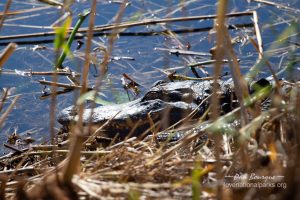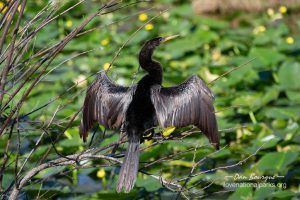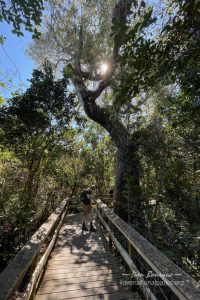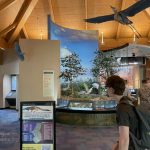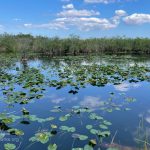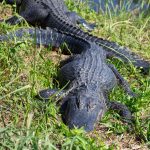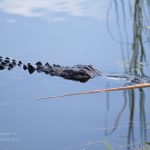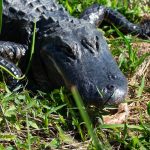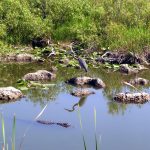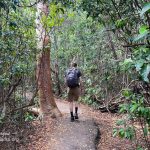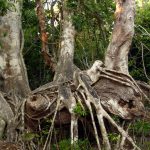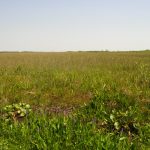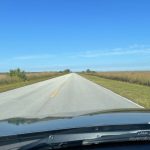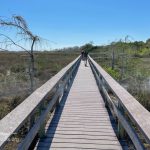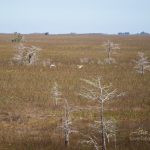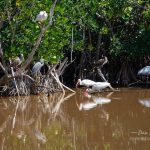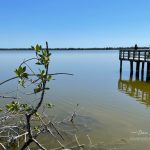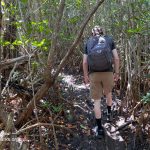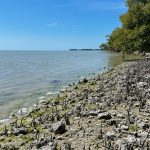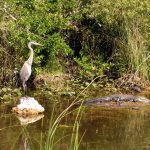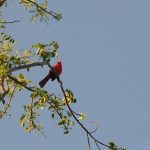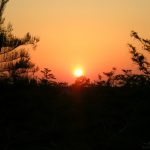 Everglades National Park, Florida, founded in 1947, protects the once-vast wetlands of southern Florida, home to an amazingly diverse collection of wildlife.
Everglades National Park, Florida, founded in 1947, protects the once-vast wetlands of southern Florida, home to an amazingly diverse collection of wildlife.
Visitor Rating (write your own review below)
Amazing wildlife
Scenery![]()
Uniqueness![]()
Wildlife![]()
Diversity![]()
ILNP Park Review
In a Word. “Teeming”
“Who has divided a channel for the overflowing water, or a path for the thunderbolt, to cause it to rain on a land where there is no one, a wilderness in which there is no man; to satisfy the desolate waste, and cause to spring forth the growth of tender grass?” -Job 38:25-27
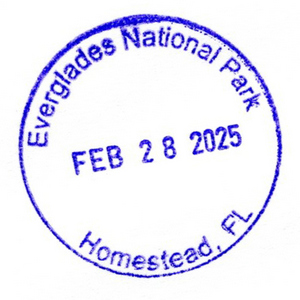 Our Visit. We’ve visited Everglades NP twice. The first time was during May as part of a trip to southern Florida which included Biscayne NP. The second time was at the end of February as park of a trip to Miami and the Florida Keys.
Our Visit. We’ve visited Everglades NP twice. The first time was during May as part of a trip to southern Florida which included Biscayne NP. The second time was at the end of February as park of a trip to Miami and the Florida Keys.
Our Weather. The weather in May was warm (high 80s) and sunny. A slight breeze kept most of the insects at bay and made for cooler walks. The weather in February was perfect–mid 70s, sunny, and very few bugs.
Overall Impression. If you live in Florida, the Everglades is nothing exciting because you see alligators, large birds, and mangrove swamps every day. However, to a visitor, the Everglades is an astonishing collection of wildlife you’ll find in few other places set in a vast and surprisingly diverse landscape of grass, swamp, and woods. While the Everglades lacks the breathtaking beauty of some other parks, it packs a myriad of surprising (and surprisingly close) encounters on a smaller scale for those willing to look.
Favorite Spot. The Anhinga Trail at the Royal Palm Visitors Center
Minimum Time Required. About 1 hour. In an hour, you can make a quick visit to either the Shark Valley (north) or the Royal Palm (east) Visitors Center and get a good close-up view of alligators and large birds. The Royal Palm Visitors Center is especially good for those looking for a quick peek at the park because it sits at the junction of grasslands, mangroves and a hardwood “hammock” of gumbo limbo trees set in a jungle. Two short (1/4 – 1/2 mile) walking trails, the Anhinga Trail and the Gumbo Limbo Trail, allow you to explore these areas easily. With a little more time, you can press to Pahayokee Trail to get a great overview of the grasslands Everglades is famous for.
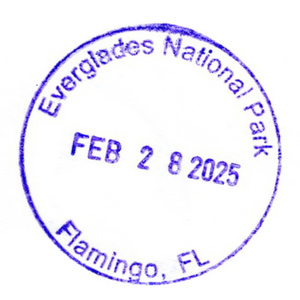 If you’re traveling along US 41 across the north side of the Everglades, stop at Shark Valley to see a dense population of gators in a thick swamp setting. If you’re not up for the 2-hour tram into the grasslands, you can walk or bike as far down the road as you’d like to get away from the crowds at the Visitors Center.
If you’re traveling along US 41 across the north side of the Everglades, stop at Shark Valley to see a dense population of gators in a thick swamp setting. If you’re not up for the 2-hour tram into the grasslands, you can walk or bike as far down the road as you’d like to get away from the crowds at the Visitors Center.
A Longer Visit. Everglades NP is well worth at least a full day. In a half to a full day, you can drive the main road from the Ernest Coe Visitors Center to Flamingo City on the southern coastline. The Coe Visitors Center has some nice displays, but it’s safe to skip it to spend more time in the park. Evenly spaced every few miles are points of interest, and each is worth at least a quick stop. Plan on spending about an hour near the Royal Palm Visitors Center so you can hike the easy Anhinga Trail and Gumbo Lingo Trail. On our first visit, as soon as we got out of the car, an 8-foot gator came walking out of the hallway next to the visitors center restrooms and along the sidewalk–talk about a close encounter right off the bat! On our second visit, two large gators were sunning right next to the short wall between the visitors center and the pond. The Anhinga Trail is a park favorite as this area is home to many alligators and several species of very active birds including anhinga, egrets, herons, cormorants, and even some swallow-tailed kites. The Gumbo Limbo Trail is an easy trail through the jungle with some close encounters with some papery red gumbo limbo trees.
Taking the main road west takes you through Pinelands, a large area of pine forest among the grasses, Pa-Hay Okee (grassy waters), Mahogany Hammock, and a series of small lakes before you get to Flamingo City. We picked some spots for the drive out and some for the drive back. The two best stops in our view along this route are Pahayokee Trail and Mahogany Hammock Trail. Both trails are short (about 1/2 a mile), built on sturdy boardwalks, and include a little shade. Pahayokee offers a classic view of the grasslands for miles, and mahogany hammock takes you through a dense jungle area which boasts the country’s largest mahogany tree.
The Flamingo City area at the end of the road offers views of the Atlantic, camping, lodging, and boat tours. If you are up for a longer visit, Flamingo City is the launching point for boat tours and canoe trips into the mangrove-lined waterways. We were content to eat lunch and admire the ocean views before heading back with a brief trek along Guy Bradley Trail to get to the water. On the return trip, there are lots of places to stop along creeks and ponds. Our favorite of these stops was West Lake which has a little boardwalk trail that overlooks the peaceful lake. We tried for a longer hike on Christopher Point Trail, but the trail was not maintained (there was a sign saying as much), and after a few hundred muddy feet and lots of spiderwebs, we decided to spend our time elsewhere. The Snake Bight Trail was better maintained, but miles of straight flat trail didn’t draw our interest. If you’re into canoeing, there are many canoe trails in this section of the park.
During our first trip, on our drive back to the Tampa area, we stopped at Shark Valley Visitors Center along US41. We were not disappointed! Unlike the main area of the park, cars are not allowed along the road. You can walk, rent a bicycle (available at the gift shop) or take the free tram (2 hours). We didn’t have time for a longer hike, but even in the first 1/4 of road we walked, we were rewarded with close-up photo ops of dozens of alligators and several large herons which live in the waterway adjacent to the road.
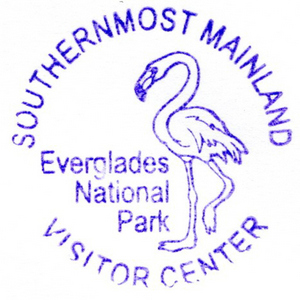 Suggestions. Keep your small children close to you in this park! Most of the trails are over water on boardwalks, and while they were well maintained, a determined child would be able to slip through the railings. Also, I wouldn’t want to tempt any gators. If you want to see the most wildlife, especially birds, you need to go in early spring near the end of the dry season (Dec-Apr). The birds were plentiful and very active in February. If you want no crowds and don’t mind bugs, the wet season (Summer and Fall) is for you. . . most people choose the former. Both February and May turned out to be good times to visit.
Suggestions. Keep your small children close to you in this park! Most of the trails are over water on boardwalks, and while they were well maintained, a determined child would be able to slip through the railings. Also, I wouldn’t want to tempt any gators. If you want to see the most wildlife, especially birds, you need to go in early spring near the end of the dry season (Dec-Apr). The birds were plentiful and very active in February. If you want no crowds and don’t mind bugs, the wet season (Summer and Fall) is for you. . . most people choose the former. Both February and May turned out to be good times to visit.
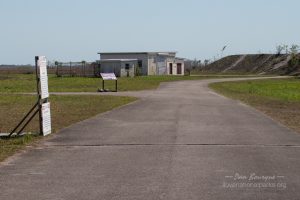
Everglades NP hosts an old Nike missile battery from the Cold War era that can be accessed from a road near the Royal Palm area (Feb)
Allow more time for driving than you think. The map makes the only road look short, but it’s 38 miles with lots of stops and you have to drive it twice. Speed limits are typically 50 mph, though, so it’s not painfully slow. If you’re interested in Cold War history, there’s an old Nike anti-aircraft missile battery. This area is behind a gate that’s only open certain hours, so if this is your thing, make sure you stop by the Ernest Coe Visitors Center to find out times for the gates and guided tours–we didn’t, and we missed the gate time by 10 minutes and could only stare at the site through the fence.
Nearby Towns Homestead, Naples, Miami (Florida)
Other Nearby Attractions Biscayne NP, Big Cypress National Preserve
Official NPS Website Everglades NP
- The Ernest Coe Visitors Center is outside of the fee area and offers some exhibits and an overview of the park (Feb)
- From the Royal Palm parking lot you can view this pond that’s home to many alligators and birds (Feb)
- Two alligators sunbathe in the morning light at Royal Palm (Feb)
- An alligator poses in classic partially submerged profile near Royal Palm (Feb)
- This alligator offered a little smile just a few feet off the path near Anhinga Trail (Feb)
- A great blue heron on a fish hunt just off the Anhinga Trail (Feb)
- Heron and gator from Anhinga trail (May)
- The Gumbo Limbo Trail is a short hike through a grove of papery red gumbo limbo trees (Feb)
- Looking more like something from the movie “Alien” than a tree, this strangler fig is one of the strangest we saw on the Gumbo Limbo Trail (May)
- View of Everglades’ famous grasslands from the Anhinga Trail (May)
- Not exactly what you would call a dense forest, but the Pinelands area is not what you’d expect from the swampy Everglades (May)
- A good portion of the main road in the park looks like this for miles (Feb)
- Like many trails in the park, Pahayokee is on a boardwalk (Feb)
- Pahayokee is a great place to overlook the vast stretches of marshy grassland that make up most of the Everglades (Feb)
- The brown waters of Mrazek Pond are a popular spot for large birds like these egrets and herons (Feb)
- A short boardwalk trail offers a nice view across West Lake (Feb)
- We tried Christopher Point Trail but didn’t make it more than a couple hundred feet due to the mud and spider webs along the unmaintained trail (Feb)
- The Flamingo Visitors Center sits on the coast at the southern edge of the park (Feb)
- Shark Valley employs guard gators to enforce traffic laws. . . (May)
- The Guy Bradley Trail is a short hike near the Flamingo VC that leads along the coast (Feb)
- A blue heron keeps a wary eye on nearby gators as it looks for fish near the Shark Valley Visitors Center (May)
- Even during the off-season, the variety of birds is astounding (May)
- Sunset through the cypress trees at Pay-Hay-Okee Overlook (May)
Write Your Own Review

